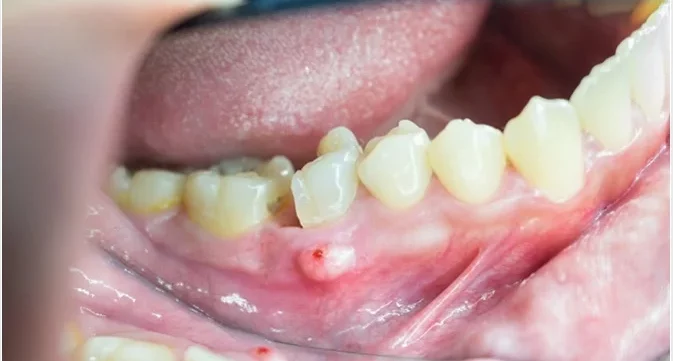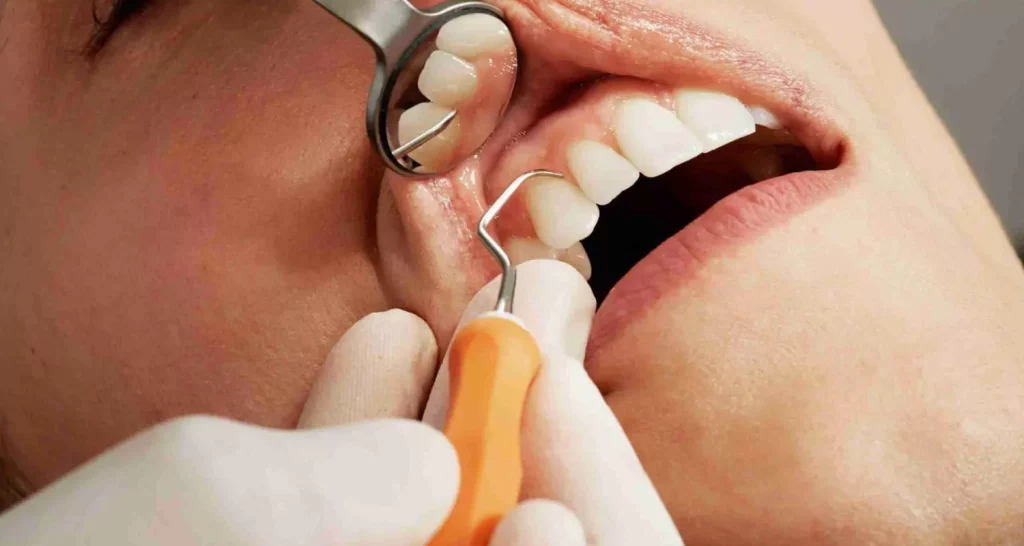Last Updated on: 21st August 2024, 03:20 am
Dental infections are the most treated oral health problem of an emergency nature since the mouth is exposed to millions of bacteria when we eat or put an object in our mouth. Diagnosis is relatively simple during a consultation, but depending upon the degree of progress, it can be difficult to manage. Most of the time abscesses on the gums are soft and warm to the touch, but in advanced tooth abscess stages, they can be hard and firm.
This condition is commonly seen in pediatric dentistry. Odontogenic infections (associated with the teeth and gums) can have different states, depending upon the severity; at times, they may require hospital care.
What is an abscess?

Dental or oral abscesses are a response to an infection in the tooth, gum, or jawbone caused by bacteria. They are generally localized as a result of a sac of pus.
When this pus has accumulated inside the gum or tooth, it generates an abscess. Without adequate and timely treatment, this can trigger major problems. The progress of developing an abscess occurs in stages. They do not disappear on their own and are usually painful. In any case, an abscess should always be checked by a dentist to prevent it from spreading to other parts of the body.
Causes of dental caries
When bacteria are introduced into the mouth, they adhere to or enter the tooth or the structures around it and subsequently multiply. Some of the main causes of an abscess are:
-
- Caries: poor hygiene and high-sugar diets as well as health conditions that suppress the immune system, medications, hormonal changes or some genetic conditions can cause cavities to appear that, if left untreated, will generate an infection.
- Gum disease: Plaque and tartar buildup causes bacteria to adhere below the gum line, eventually causing disease and infection.
- Injuries: Injuries caused in or around the tooth increase the probability of a dental abscess. These are usually caused by trauma or surgery; but in either case, the infection can spread to the root of the tooth or even the bone.
NOTE: In any of the cases, timely treatment is important. Your dentist will indicate the type of antibiotics and analgesics to use until the abscess and underlying infection disappear.
What are the tooth abscess stages?

A dental abscess is the final stage of an oral infection, but several affectations likely have previously occurred:
-
- White spots: The demineralization of the tooth is represented by white spots below the surface of the enamel produced by the consumption of sugars and carbohydrates. When metabolized by bacteria, they produce acids that attack the tooth.
- Enamel affectation: at this stage, no symptoms are experienced, but it implies there is damage to the outermost layer of enamel due to caries that erode the tooth from the inside. It is possible that white spots will show, and sometimes you will develop sensitivity to cold and heat.
- Deterioration of the dentin: Once caries have passed the enamel, it affects the layer below it, which is yellowish – called dentin. At this stage, it is possible to experience dental sensitivity and even pain. There may be a visible hole or cavity in the tooth. It is possible to remove the decay and put it in a filling.
- Pulp involvement: We can find an abscess in the inner part of the tooth, the deepest layer. Therefore, when the caries reach the pulp, the pain is intense and acute. When a cavity forms, it can attack the nerve of the tooth. At this point, the nerve dies and an abscess begins to form.
- Formation of an abscess: it is one of the final stages of caries since when bacteria reach the pulp, they can spread toward the gums and jaw, even going deep. Once this happens, swelling or inflammation (with localized heat – a sign of fever) will be observed in the gum near the tooth along with redness. The patient may experience some pain.
- Complications and final stage: caries have generated another type of gum disease that deteriorates the gum, the tooth, and possibly the jaw, generating, tooth loss, tooth fracture, or in more serious cases, an infection carried through the blood vessels, called sepsis.
Types of dental abscess

The type of abscess will depend on the progress of caries or the bacteria that have affected the tooth:
-
- Caries: these are caused by bacteria and can reach stage 3 in the deterioration or affectation of the dentin. They occur mainly due to a diet rich in sugars and carbohydrates, as well as poor oral hygiene.
-
- Pulpitis: when the pulp is affected by oral bacteria or the progression of caries, it is possible to show an exacerbation of existing inflammation. However, it is possible that it is reversible pulpitis, where sometimes it is asymptomatic or presents mild pain and only the external part of the pulp has been affected. It is possible to save the tooth and reverse the process; but in cases of irreversible pulpitis, it can be purulent and necrotic, acutely causing an intense, continuous pain that can radiate to other areas. It is sometimes a stabbing sensation that initially increases with exposure to cold. It eventually leads to pulpal necrosis, where the symptoms may stop but when they return, they are much more intense.
-
- Periapical abscess: this is an inflammation of the tissues surrounding the outer tip of the root, where the pain is extreme or dull, It hurts when eating or talking, and sometimes pus may come out.
-
- Periodontal abscess or periodontal infections: this entails the involvement and infection of the structures surrounding the tooth and the root as well as in the gums. Gingivitis occurs when only the gums are affected, generated by an infection due to the accumulation of bacteria that, in turn, adhere to the tooth, form plaque and when not removed over time, generate tartar below the gumline. Periodontitis follows, which involves deeper tissues, with the destruction of some, such as the connective tissue, allowing the tooth to loosen and move. The pain in general at this stage is intense and sharp; the gums are red and bleed easily.
-
- Pericoronal abscess: also called pericoronitis, this acute infection is located in the tissues that cover the crown of the tooth. It usually occurs at the eruption of the third molars (wisdom teeth). The condition generally occurs when the tooth does not come out or erupt completely, leaving part of the tissue on the upper part of the crown. Food debris can get trapped, which eventually becomes an infection or abscess.
Recommendations
Adequate and regular hygiene with tooth brushing must be done at least twice a day, along with flossing, rinsing, and routine visits to the dentist. This will help prevent an infection from occurring and if found, it can be treated and eliminated as soon as possible, through a treatment defined by the dental professional.
It is important to review the type of food you eat in order to identify whether you indulge in high consumption of carbohydrates and sugars. It should be remembered that an untreated abscess could lead to complications that compromise health and life.
Contact us
If you have any questions about this or other topics, you can contact us at Channel Islands Family Dental as well as our page on Facebook. We look forward to your visit and we will make a timely diagnosis. Our dentists in Oxnard, Santa Paula, Ventura, Newbury Park, and Port Hueneme will be able to guide you toward the best treatment to take care of your health and give you back your best smile.
Bibliography
- Sanders JL, Houck RC. Tooth Abscess. [Updated 2022 Feb 23]. In: StatPearls [Internet]. Treasure Island (FL): StatPearls. https://www.ncbi.nlm.nih.gov/books/NBK493149/
- R. Rodriguez E, et. to the. (2009). Antibiotic treatment of odontogenic infection. Inf Ter Nac Health System 2009; 33:67-79. https://www.sanidad.gob.es/biblioPublic/publicaciones/recursos_propios/infMedic/docs/vol33_3TratAntibInfecOdont.pdf
- WebMD (Aug 17, 2020). Tooth Infection Treatment. https://www.webmd.com/oral-health/treatments-tooth-infections
- DiFoggio, W, BS. (June 30. 2022). 5 Stages Of An Abscessed Tooth & What To Do. https://www.teethtalkgirl.com/dental-health/stages-of-abscess-tooth
- NHS Info. (Aug 04, 2022). Tooth abscess. https://www.nhsinform.scot/illnesses-and-conditions/mouth/dental-abscess
- Veronika. (September 29, 2022). Tooth Abscess Stages, Symptoms & Treatment. https://www.newmouth.com/oral-health/dental-abscess/
- Newman, T. (December 4, 2017). What’s to know about dental abscesses?. https://www.medicalnewstoday.com/articles/170136



